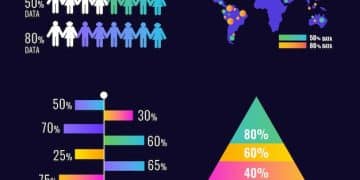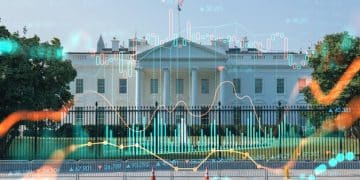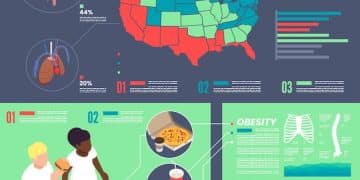2025 US Census Data: 5 Key Demographic Shifts & Policy Impact
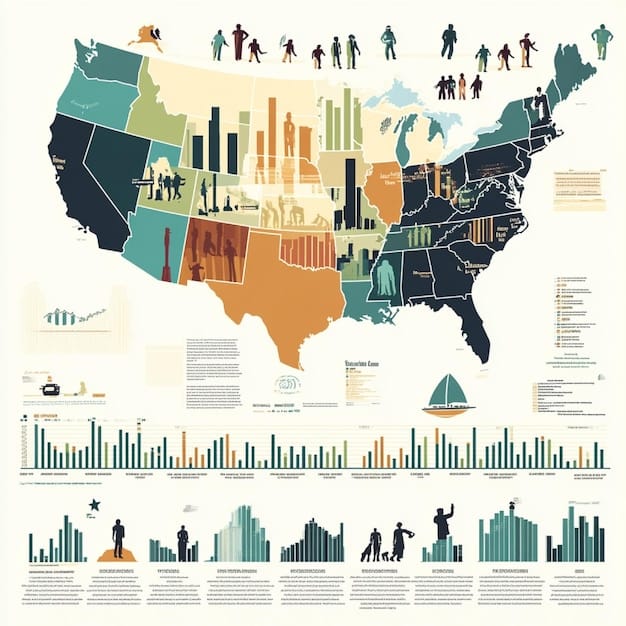
The 2025 US Census Data: 5 Key Demographic Shifts Impacting National Policy reveals crucial changes in population distribution, age structure, racial composition, urbanization, and household dynamics, profoundly influencing policy decisions across healthcare, education, infrastructure, and economic development.
As we approach the mid-decade mark, the forthcoming 2025 US Census Data: 5 Key Demographic Shifts Impacting National Policy stands as a pivotal moment for understanding the evolving American landscape. This data offers a crucial snapshot, guiding policymakers, businesses, and communities in navigating the complexities of a changing nation.
The Evolving American Landscape: A Preview of 2025 Census Insights
The U.S. Census Bureau’s periodic data collections are more than just numbers; they are the bedrock upon which national policy is built. The 2025 data, derived from ongoing surveys and population estimates, is set to illuminate significant shifts that have been subtly reshaping the fabric of American society. These insights are vital for ensuring that federal, state, and local policies remain responsive and relevant to the needs of the populace.
Understanding these shifts is not merely an academic exercise. It directly impacts resource allocation, electoral representation, and the very design of public services. From healthcare infrastructure to educational funding, the demographic currents revealed by the census data dictate where investments are most needed and how programs can be most effectively implemented.
The Crucial Role of Census Data in Policy Formulation
Census data serves as the compass for policy formulation. Without an accurate understanding of who Americans are, where they live, and how their characteristics are changing, policies risk becoming misaligned with reality. The information gathered informs decisions on everything from congressional redistricting to the distribution of billions in federal funding.
- Resource Allocation: Data guides the distribution of federal funds for essential services like schools, hospitals, and emergency services.
- Economic Development: Businesses use demographic trends to identify emerging markets and tailor products and services.
- Social Planning: Non-profits and community organizations leverage data to address specific population needs and advocate for their constituents.
The upcoming 2025 data will provide an updated foundation, allowing for more nuanced and precise policy interventions that reflect contemporary American life.
Furthermore, the census data offers a historical continuum, enabling researchers and policymakers to trace patterns over time. This longitudinal perspective is invaluable for anticipating future trends and developing proactive strategies rather than merely reactive ones. For instance, understanding long-term migration patterns can inform future infrastructure investments in growing regions.
Shift 1: Regional Redistribution and Urbanization Trends
The movement of people within the United States has always been a dynamic force, and the 2025 Census data is expected to highlight a continued, albeit nuanced, regional redistribution. While the general trend of population growth in the Sun Belt states persists, there are emerging complexities in metropolitan and exurban areas. This shift is not just about state-to-state migration; it’s also about the evolving relationship between urban core, suburban rings, and increasingly, remote work-fueled exurban growth.
Many Americans are reassessing their living priorities, driven by factors like housing affordability, climate concerns, and the increased feasibility of remote work. This has led to both concentrated growth in certain amenity-rich exurbs and a revitalized interest in smaller, more affordable metropolitan areas. The data will show how these granular shifts are impacting local demands for housing, transportation, and public services.
The Rise of Exurbia and Its Policy Implications
Exurban areas, located beyond traditional suburbs but still within commuting distance of major cities, are experiencing significant growth. This influx of residents brings both opportunities and challenges for local governance.
- Infrastructure Strain: Rapid exurban growth can overwhelm existing roads, utilities, and public transport systems, necessitating significant investment.
- Environmental Concerns: Sprawling development encroaches on natural habitats and agricultural land, raising questions about sustainable land use.
- Service Provision: Providing adequate schools, healthcare facilities, and emergency services to a dispersed population presents unique logistical hurdles.
Policymakers must grapple with how to manage this growth sustainably, balancing economic development with environmental protection and ensuring equitable access to services. The 2025 data will be crucial in quantifying these trends and informing targeted policy responses.
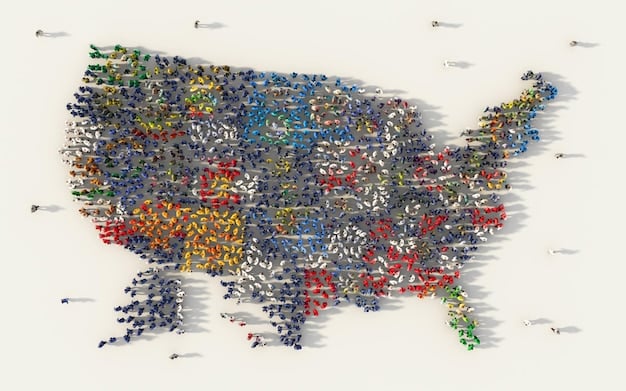
The implications extend to political representation as well. As populations shift, so too does the balance of power in state legislatures and the U.S. House of Representatives. Understanding which regions are gaining or losing residents is fundamental for fair redistricting and ensuring that all voices are adequately heard.
Shift 2: Aging Population and Its Socioeconomic Footprint
The United States continues its trajectory towards an older population, a demographic shift that will be starkly evident in the 2025 Census data. The aging of the Baby Boomer generation, coupled with declining birth rates and increased longevity, creates a unique set of challenges and opportunities across all sectors of society. This isn’t merely about more older adults; it’s about a fundamental rebalancing of age demographics with profound socioeconomic implications.
The proportion of Americans aged 65 and over is projected to grow significantly, while the proportion of younger age groups may stabilize or even decline in some areas. This shift reverberates through labor markets, social security, healthcare systems, and even housing design. A critical examination of these trends will inform how the nation cares for its elderly and leverages their experience, while also ensuring the vitality of its younger generations.
Responding to the Needs of an Older America
An aging population necessitates a re-evaluation of current policies and infrastructures. Healthcare, in particular, faces immense pressure as the demand for geriatric care, long-term support, and chronic disease management escalates.
- Healthcare System Adaptation: Increased demand for specialized medical services, preventative care, and affordable prescription drugs.
- Labor Market Adjustments: Potential workforce shortages and the need for policies supporting extended working lives or phased retirements.
- Social Security and Medicare Solvency: Mounting pressure on entitlement programs, requiring ongoing policy discussions for long-term sustainability.
Furthermore, communities must consider the livability for older adults, including accessible transportation, age-friendly housing, and social engagement opportunities. The 2025 Census will provide updated figures that underscore the urgency of these policy considerations.
Beyond the challenges, an aging population also represents a vast reservoir of experience and knowledge. Policies that encourage active aging, volunteering, and continued employment can harness this valuable resource, transforming potential burdens into societal assets. This perspective encourages a more holistic approach to age demographics, moving beyond mere dependency ratios.
Shift 3: Increasing Racial and Ethnic Diversity
The United States has always been a nation of immigrants, and the 2025 Census data will further cement its status as a multicultural mosaic. The growing diversity across racial and ethnic lines is one of the most significant demographic transformations of the 21st century. This shift is not confined to traditional gateway cities; it is now pervasive across urban, suburban, and even rural communities, fundamentally altering the social and cultural landscape of the nation.
This diversity brings a richness of perspectives, traditions, and economic dynamism but also presents new challenges for social cohesion and equity. Policies related to education, language access, economic opportunity, and healthcare must evolve to reflect and serve this increasingly diverse populace. The data will provide granular detail on these shifts, offering insights into where specific ethnic groups are growing and how they are impacting local communities.
Crafting Inclusive Policies for a Diverse Nation
Increased diversity demands a proactive approach to policy-making that ensures equitable access and representation for all demographic groups. This involves addressing historical inequities and designing programs that are culturally competent and language-accessible.
- Educational Equity: Developing curricula that reflect diverse histories and cultures, and providing resources for English language learners.
- Healthcare Disparities: Tackling health outcome gaps among different racial and ethnic groups through targeted interventions and culturally sensitive care.
- Economic Inclusion: Fostering entrepreneurship within minority communities and addressing systemic barriers to economic advancement.
Moreover, the political landscape is continuously being reshaped by these demographic changes, influencing voter turnout, political affiliations, and the priorities of elected officials. The 2025 Census will reinforce the need for policies that promote social integration and uphold civil rights for all segments of the population.
The cultural impact is equally profound, with new traditions, cuisines, and artistic expressions enriching the national tapestry. Policies that support cultural institutions and community-based organizations can play a critical role in fostering understanding and celebrating this burgeoning diversity as a national strength.
Shift 4: Changing Household and Family Structures
The traditional nuclear family, long considered the bedrock of American society, continues to evolve, and the 2025 Census data will likely underscore the increasing variety of household and family structures. This shift extends beyond changes in marriage rates to include a rise in single-person households, multi-generational living arrangements, cohabiting couples, and families headed by single parents or same-sex partners. These diverse structures reflect evolving societal norms, economic pressures, and personal preferences.
Understanding these new configurations is crucial for architects of social policy, urban planners, and businesses. Housing design, social welfare programs, educational support systems, and even consumer markets must adapt to cater to a broader spectrum of household needs and lifestyles. The data will provide a more detailed panorama of how Americans are choosing to live and form families.
Adapting Policy to Modern Family Dynamics
The diversification of household structures requires a re-evaluation of policies that were often designed with a specific family model in mind. This includes everything from tax codes to zoning laws.
- Housing Policy: Developing more flexible housing options, including smaller living units, co-housing models, and homes suitable for multi-generational families.
- Social Support Systems: Reassessing eligibility criteria for social benefits to better support single-parent households, cohabiting couples, and other non-traditional families.
- Work-Life Balance: Implementing policies like paid family leave and flexible work arrangements that acknowledge diverse caregiving responsibilities.
Additionally, the data will also inform targeted efforts to address issues such as child poverty and elder care within these varied family settings. Recognizing the strength and resilience of diverse family forms is vital for creating policies that genuinely support American households.

This demographic shift also challenges conventional marketing and community planning. Public services and private industries need to tailor their offerings to resonate with a mosaic of family types, ensuring that their messaging and support systems are inclusive and relevant.
Shift 5: Evolving Educational Attainment and Workforce Dynamics
The educational landscape of the United States is in constant flux, and the 2025 Census data will provide critical insights into how attainment levels are changing and, in turn, reshaping the American workforce. This shift isn’t uniform; it involves rising levels of higher education in some demographics, alongside persistent disparities in others, and a growing emphasis on vocational training and lifelong learning. The data will illuminate the nuanced connections between education, employment, and income mobility.
As the economy shifts towards knowledge-based industries and automation, the demand for specific skills continues to evolve rapidly. The census data will offer a clearer picture of regional and demographic skill gaps, informing workforce development initiatives and educational reforms. This understanding is paramount for maintaining U.S. competitiveness and ensuring a prosperous future for all citizens.
Bridging Skill Gaps and Fostering Lifelong Learning
Policies must proactively address the changing nature of work and the skills required to thrive in the 21st-century economy. This requires a collaborative effort between educational institutions, industry, and government.
- Investment in STEM and Vocational Training: Prioritizing funding for science, technology, engineering, and mathematics education, as well as skilled trades programs.
- Addressing Educational Disparities: Implementing programs to improve educational outcomes in underserved communities and for marginalized groups.
- Support for Adult Learning: Creating accessible pathways for reskilling and upskilling for adults displaced by automation or seeking career changes.
- Bridging the Digital Divide: Ensuring equitable access to broadband internet and digital literacy programs, essential for modern education and employment.
The 2025 data will highlight which educational pathways are yielding the best economic outcomes and where policy interventions are most needed to ensure a highly skilled and adaptable workforce for the future. Understanding these shifts is not only about economic growth, but also about social equity.
Furthermore, as the gig economy expands and traditional employment models evolve, policies must also consider how to provide benefits and protections to a more flexible workforce. The intersection of educational attainment with employment types will offer invaluable perspective here.
| Key Demographic Shift | Impact on National Policy |
|---|---|
| 🗺️ Regional Redistribution | Influences infrastructure planning, resource allocation, and political representation. |
| 👵 Aging Population | Demands healthcare system adaptations, social security reforms, and workforce adjustments. |
| 🌍 Increasing Diversity | Requires inclusive policies in education, healthcare, and economic opportunity. |
| 🏠 Changing Households | Shapes housing policy, social support systems, and work-life balance initiatives. |
Frequently Asked Questions About 2025 US Census Data
The 2025 US Census Data is crucial because it provides an up-to-date statistical portrait of the nation. It directly informs decisions on the allocation of billions in federal funding for schools, hospitals, and infrastructure, influences political representation through redistricting, and helps tailor social programs to meet the current needs of diverse communities across the United States.
Regional population shifts, including continued urbanization and exurban growth, will significantly impact policymaking by creating new demands for housing, transportation, and public services in growing areas. These shifts also influence electoral boundaries and the distribution of federal resources, requiring adjustments in state and local planning to ensure equitable service provision and representation.
An aging US population has major implications for policy, primarily affecting healthcare systems with increased demand for geriatric care and chronic disease management. It also pressures social security and Medicare solvency, and may lead to labor market adjustments requiring policies that support an older workforce or ensure continued economic productivity. Housing and community infrastructure also need adaptation.
Increasing racial and ethnic diversity greatly influences national policy by necessitating more inclusive approaches in education, healthcare, and economic development. Policies must address historical disparities, ensure language access, and promote cultural competency to serve a multicultural populace effectively. It also impacts political representation and voting patterns, fostering a need for equity-focused governance.
Evolving household structures, such as single-person households and multi-generational living, will likely lead to policy changes in housing and social support systems. This includes developing flexible housing options, re-evaluating eligibility for social benefits, and implementing work-life balance policies that acknowledge diverse caregiving needs. Policies will need to recognize and support a broader spectrum of family forms beyond traditional models.
Conclusion: Charting the Future with Data-Driven Policy
The 2025 US Census Data: 5 Key Demographic Shifts Impacting National Policy serves as an indispensable roadmap for the nation’s future. The insights garnered from these shifts—regional redistribution, an aging population, increasing diversity, evolving household structures, and changing educational attainment—are not mere statistical anomalies but profound indicators of the country’s trajectory. Policymakers at all levels must embrace this data with diligence and foresight, translating numbers into responsive and equitable strategies. Ignoring these demographic realities would mean designing policies in a vacuum, failing to address the fundamental needs and aspirations of the American people. As the nation continues to evolve, the census data remains our most reliable guide for fostering a more inclusive, prosperous, and resilient society.



